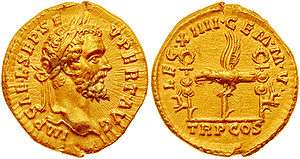Legio XIV Gemina
| Legio XIV Gemina Martia Victrix | |
|---|---|
 | |
| Active | 41 BC to early 5th century at least |
| Country | Roman Republic - 1st & 2nd raising under Caesar, 2nd Triumvirate - Roman Empire - 3rd raising was a joining with another understrength legion under Octavian after the Battle of Actium |
| Type |
Roman legion (Marian) later a comitatensis unit |
| Role | Heavy Infantry (occasionally cavalry support when operating independently) |
| Size | Varied over unit lifetime. Approx. 3,500 fighting men + support at the time of creation, ~ 5,000 to 6,000 men when operating independently during Imperial period.] |
| Garrison/HQ |
Moguntiacum (9–43) Vindobona (92–106) Carnuntum (106–5th century) |
| Nickname(s) |
Gemina Martia Victrix, "Twinned Martial and Victorious" Martia Victrix, "martial and victorious" (added by Augustus) Pia VI Fidelis VI, "six times faithful, six times loyal" (added by Gallienus) |
| Mascot(s) | Capricorn |
| Engagements |
Gallic Wars (58-51 BC) Caesar's Civil War (49-45 BC) Post-Caesarian civil war (44 BC) Liberators' civil war (44–42 BC) Sicilian revolt (44–36 BC) Perusine War (41–40 BC) Final War of the Roman Republic (32–30 BC) Roman conquest of Britain (43) Year of the Four Emperors (69) revolt of Saturninus (89) Dacian Wars (101–106) Verus Parthian campaign (161–166) Marcus Aurelius Marcomannic campaign (168–180) Septimius Severus rise to power (193–194) Severus Parthian campaign (198) vexillationes of the 14th participated in many other campaigns. |
Legio quarta decima Gemina ("The Twinned Fourteenth Legion") was a legion of the Imperial Roman army, levied by Julius Caesar in 57 BC. The cognomen Gemina (Twinned) was added when the legion was combined with another understrength legion after the Battle of Actium. The cognomen Martia Victrix (martial and victorious) was added sequentially following their service in the Pannonian War c. AD 9 and the defeat of Boudicca in AD 61. The emblem of the legion was the Capricorn,[1] as with many of the legions levied by Caesar,[1] their shield device displayed the thunderbolt of Jupiter with wings. It was the only legion to do so in the same manner as the Praetorian Guard.
Under Caesar
The XIV G.M.V was first raised by Caesar in Cisalpine Gaul during his raids into, and conquest of, Gaul. Following its first destruction under Caesar it was immediately reconstituted. Their enlistment term was for 16 years, as per the other Republican legions (though Augustus raised that to 20). For years after the Massacre at Atuatuca carried out by the Eburones under Ambiorix together with Cativolcus[2] they were viewed as an unlucky legion, but survived due to the efforts of their Aquilifer, Lucius Petrosidius.[3] They were frequently left behind to guard the camp during battles and raids.
Under Germanicus
The XIV G.M.V fought under General Germanicus Caesar against the German rebel Hermann, better known as Arminius. A decade before this campaign, Hermann succeeded in wiping out three entire legions in the Battle of the Teutoburg Forest, one of the greatest disasters in Roman military history. They secured a victory for Germanicus, and earned him a triumph from his adopted father, Emperor Tiberius.
Invasion of Britain
Stationed in Moguntiacum, Germania Superior from AD 9, XIV Gemina Martia Victrix was one of four legions used by Aulus Plautius and Claudius in the Roman invasion of Britain in AD 43. It built its legionary fortress at Mancetter on Watling Street and by AD 58 it had moved its base to Wroxeter.[4]
It took part in the defeat of Boudicca in 60 or 61. At the Battle of Watling Street the 14th defeated Boudicca's force of 230,000, according to Tacitus and Dio, with their meager force of 10,000 Legionaries and Auxiliaries. This act secured them as Nero's "most effective" legion, and he kept them garrisoned in Britain during the next few years to keep the uneasy tribes in check.
In 67 AD the legion was sent to the Balkans in preparation for a campaign against the Parthians that Nero planned but which never materialised.[5]
Rebellion on the Rhine
In AD 89 the governor of Germania Superior, Lucius Antonius Saturninus, rebelled against Domitian, with the support of the XIVth and of the XXI Rapax, but the revolt was suppressed.
When the XXIst legion was lost in AD 92, XIV Gemina was sent to Pannonia to replace it, setting up camp in Vindobona (Vienna). After a war with the Sarmatians and Trajan's Dacian Wars (101–106 AD), the legion was moved to Carnuntum, where it stayed for three centuries. Some sub-units of the Fourteenth fought in the wars against the Mauri, under Antoninus Pius, and the legion participated in the Parthian campaign of Emperor Lucius Verus. During his war against the Marcomanni, Emperor Marcus Aurelius based his headquarters in Carnuntum.
In support of Septimius Severus
In AD 193, after the death of Pertinax, the commander of the Fourteenth, Septimius Severus, was acclaimed emperor by the Pannonian legions, and above all by his own. XIV Gemina fought for its emperor in his march to Rome to attack usurper Didius Julianus (193), contributed to the defeat of the usurper Pescennius Niger (194), and probably fought in the Parthian campaign that ended with the sack of the capital of the empire, Ctesiphon (198).

In support of imperial candidates
In the turmoil following the defeat of Valerian, the XIV Gemina supported usurper Regalianus against Emperor Gallienus (260), then Gallienus against Postumus of the Gallic Empire (earning the title VI Pia VI Fidelis—"six times faithful, six times loyal"), and, after Gallienus' death, Gallic Emperor Victorinus (269–271).

5th century
At the beginning of the 5th century, XIV Gemina was still assigned at Carnuntum. It probably dissolved with the collapse of the Danube frontier in the 430s. The Notitia Dignitatum lists a Quartodecimani comitatensis unit under the Magister Militum per Thracias; it is possible that this unit is XIV Gemina.
See also
References
- 1 2 L. J. F. Keppie, Legions and Veterans: Roman Army Papers 1971–2000, page 128.
- ↑ "Atuatuca: provincial town in Gallia Belgica, modern Tongeren". Jona Lendering. Retrieved 14 May 2013.
- ↑ Gaius Julius Caesar (1914). "Book V, Chapter 37". In Holmes, T. Rice. Commentarii de Bello Gallico. Oxford: Clarendon Press. Retrieved April 25, 2016.
- ↑ Rome Against Caractacus, G. Webster. ISBN 0713472545, P 49
- ↑ Livius.org, Legio XIIII Gemina: http://www.livius.org/articles/legion/legio-xiiii-gemina/
- Dando-Collins, Stephen Legions of Rome.
- Mommsen, Theodor The History of Rome, Volume 1.
- Pollard, Nigel & Berry, Joanne The Complete Roman Legions.
- Parker, H. M. D. The Roman Legions.
- Ireland, Stanley Roman Britain: A Sourcebook (Routledge Sourcebooks for the Ancient World), 3rd Edition.
External links
- Legio XIIII Gemina at livius.org
